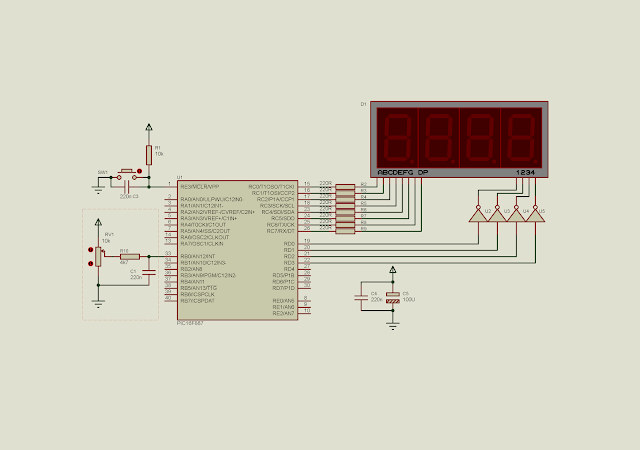To use the ADC interrupt, we must enable the,
- Global interrupt control bit (GIE)of the INTCON register
- ADC interrupt enable bit (ADIE) of the PIE1 register,
and clear the ADC complete reading interrupt flag (ADIF) of the PIR1 register.
To read the ADC using interrupt method,
- set 'GO' of the ADCON0 to '1'
- test the ADIF flag
- if ADIF = 1, we can get the ADC result
- clear ADIF
In this example, I use ADC interrupt to return a completed ADC reading result. Timer 0 is used for initiating the ADC reading for every one second. Both ADC and timer use interrupt ISR.
 |
| Analog voltage input fed to AN12. A multiplexed SSD display the ADC reading result in decimal. |
C source code's here:
#include<xc.h>
// PIC16F887 Configuration Bit Settings
// CONFIG1
#pragma config FOSC = XT
#pragma config WDTE = OFF
#pragma config PWRTE = OFF
#pragma config MCLRE = ON
#pragma config CP = OFF
#pragma config CPD = OFF
#pragma config BOREN = ON
#pragma config IESO = ON
#pragma config FCMEN = ON
#pragma config LVP = ON
// CONFIG2
#pragma config BOR4V = BOR40V
#pragma config WRT = OFF
/*_XTAL_FREQ use for __delay*/
#define _XTAL_FREQ 4000000
void driveDisplays(unsigned int result){
unsigned char ssd[16]={0x3F,0x06,0x5B,0x4F,0x66,0x6D,0x7D,
0x07,0x7F,0x6F,0x77,0x7C,0x39,0x5E,0x79,0x71};
//Digit 1 1000's
PORTD=0x00;
PORTC=ssd[result/1000];
if(result>=1000)PORTD=0x01;
__delay_ms(10);
//Digit 2 100's
PORTD=0x00;
PORTC=ssd[(result%1000)/100];
if(result>=100)
PORTD=0x02;
__delay_ms(10);
//Digit 3 10's
PORTD=0x00;
PORTC=ssd[(result%100)/10];
if(result>=10)
PORTD=0x04;
__delay_ms(10);
//Digit 4 1's
PORTD=0x00;
PORTC=ssd[result%10];
PORTD=0x08;
__delay_ms(10);
}
unsigned int readADC(void){
GO=1;
while(GO);
__delay_ms(10);
return (ADRESH<<8)+ADRESL;
}
void portSetup(void){
/*Analog and digital Port
Configuration*/
PORTB=0x00;
PORTC=0x00;
PORTD=0x00;
TRISB=0x01;
TRISC=0x00;
TRISD=0x00;
}
void adcSetup(void){
/*Result is right justify*/
ADFM=1;
/*By default is analog,
but again set it to analog*/
ANS12=1;
/*Select FRC Clock of ADC module*/
ADCON0bits.ADCS=0x03;
/*Turn on ADC Module*/
ADON=1;
/*Select AN12 RB0*/
ADCON0bits.CHS=0b1100;
}
void interruptSetup(void){
/*Select FOSC*/
T0CS=0;
/*Select timer 0 Prescaler*/
PSA=0;
/*Enable Timer 0 Overflow
interrupt*/
T0IE=1;
/*Turn on Global interrupt
Control*/
GIE=1;
/*Enable Peripheral Interrupt*/
PEIE=1;
/*Enable ADC complete reading
interrupt*/
ADIE=1;
/*Clear ADC interrupt Flag*/
ADIF=0;
/*Clear interrupt flag*/
T0IF=0;
/*Clear timer 0 register*/
TMR0=0;
}
unsigned int adcResult;
unsigned char oneSecondTick=0;
void main(void){
portSetup();
adcSetup();
interruptSetup();
while(1){
driveDisplays(adcResult);
}
}
void interrupt _ISR(void){
/*If timer 0 Overflow*/
if(T0IF){
oneSecondTick+=1;
T0IF=0;
}
/*If it's one second*/
if(oneSecondTick>=15){
oneSecondTick=0;
GO=1;
}
/*If ADC reading completed*/
if(ADIF){
adcResult=(ADRESH<<8)+ADRESL;
ADIF=0;
}
}
 |
| The ADC reading acquires 921 digital value result in decimal. |
Back to main tutorials page.



No comments:
Post a Comment